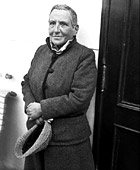Gertrude Stein was born Feb. 3, 1874, in Allegheny, Pennsylvania to Daniel and Amelia Stein, spent her infancy in Vienna and Paris, then later grew up in Oakland, California. She studied psychology at Radcliffe under William James, and apparently had somewhat of a close friendship with the philosopher. During final examinations she'd become exhausted going to the opera late all week, and in the final exam she simply wrote James a note that said, "I am so sorry but I really do not feel a bit like an examination paper in philosophy to-day," and refused to take the exam. James sent her a postcard the next day saying he'd often felt that way himself as a student, and he gave her an A in the class.
At William James's suggestion, upon her graduation from Radcliffe Stein enrolled in medical school at Johns Hopkins University, intending to eventually go into psychiatry. But she left just short of graduating with a medical degree, and moved to Paris with her brother Leo, to live on inheritance.
In Paris Gertrude and Leo Stein began to establish themselves in high society, Leo making a name for himself as an art critic, Stein as a central figure in the painting and literary communities. According to her memoir, The Autobiography of Alice B. Toklas, Stein was the first ever to purchase a Matisse painting, when the painter was poor and his family in dire straits, and she was among the first to appreciate the then-unknown painter Pablo Picasso. Also in Paris Stein met another American expatriate, Alice B. Toklas, and soon Toklas moved in with Stein. They remained lifelong partners. Stein entertained and was close friends with many major 20th century figures in painting, poetry, and fiction, and while her own work remained obscure, her opinion was respected. Her eye for great paintings is still true down to our day, those whom she praised when they were nobodies having become immortals in our own time.
Her first published book was the collection of novellas Three Lives, which is the gently-written exposition of the lives of three working-class women of different nationalities. She paid for the publication of the first edition herself, but later the work was picked up by a publisher, and it is still probably her most-appreciated work. After the completion of her most ambitious project, the 925-page novel The Making of Americans, in 1911, Stein focused much of her time on smaller pieces, writing dozens of portraits of people she came into contact with, and other brief works. She lacked widespread popularity and appreciation until the age of 58 when she published her very popular memoir, The Autobiography of Alice B. Toklas.
When Germany invaded France in 1914, Stein happened to be in England with Toklas at the family home of the philosopher Alfred North Whitehead. As news of German armies approaching Paris came in, Stein was asked if she was worried about her manuscripts in Paris, which were the only copies of a large portion of her writing. And the answer was that "she thought neither of manuscripts nor of pictures [original Picassos and Matisses, among others], she thought only of Paris and she was desolate." [From The Autobiography of Alice B. Toklas.] But when the Germans retreated, not having taken the city, Stein and Toklas returned, to later volunteer with the Red Cross until the termination of the war, Stein becoming a favorite among the young soldiers.
She remained in France until her death on July 29, 1946, at 72 years of age. The majority of her work was unpublished at her death, or published only with very small press runs. Her legacy remains debated in terms of status in the canon, but it is agreed that she is a major figure of the Modernist period. The claim that she is experimental to the point of complete unintelligibility only applies to certain of her works, and her style evolved over time and went through several phases. The fact that her works continue to be reissued by major publishers 60 years after her death speaks to her continued appreciation and importance. |






